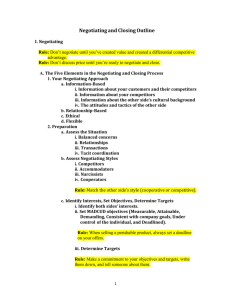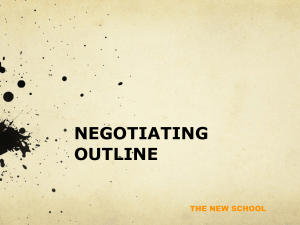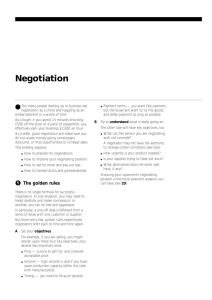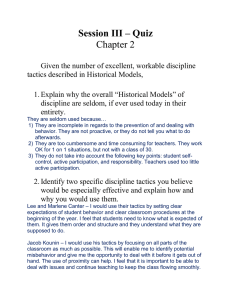Negotiating - New School
advertisement
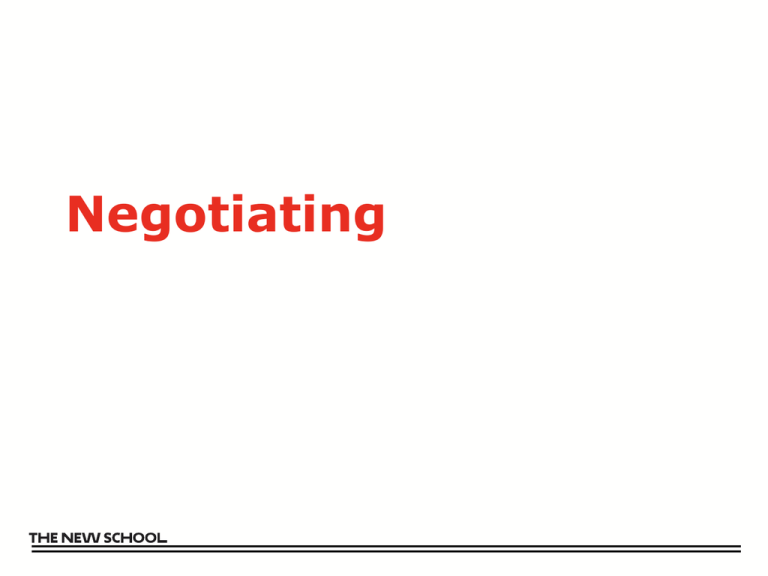
Negotiating Negotiating • Basic rule of negotiating: “You never get anything you don’t ask for.” • Don’t negotiate until you’ve created value – a differential competitive advantage. • Don’t discuss price/cost until you’re ready to negotiate and close. • Negotiate to close the deal. The Negotiating and Closing Process • Your Negotiating Approach 1. Information-based • Information about your customers and their competitors • Information about your competitors • Information about the other side’s cultural background • The style and tactics of the other side 2. Relationship-based 3. Ethical 4. Flexible Preparation 1. Assess the situation. – There are four basic bargaining situations depending on: – The perceived importance of the ongoing relationship – The perceived conflict over the the stakes involved (to what degree do both sides want the same limited resource such as money, power, terms, etc.) The Situational Matrix Perceived Conflict Over Stakes High Low High I. Balanced Concerns: Business partnership, joint venture, merger II. Relationships: Marriage, friendship, or work team Importance of Relationship III. Transactions: Divorce, house sale, or stock market transaction Low IV. Tacit Coordination: Highway intersection or airplane seating Negotiating 1.Tacit Coordination - Calls for tactful avoidance of conflict, not negotiation. 2.Transactions – Stakes, such as price, are substantially more important than relationships. Leverage counts. 3.Relationships - Treat the other party well, generously, the stakes are secondary. Accommodate. 4.Balanced Concerns - Problem solving and compromise are vital. Stakes and relationships equally important. Preparation 2. Assess negotiating styles. – – – – – • Competitors Accommodators Conflict Avoiders Problem Solvers Cooperators Match the other side’s style if Competitor Problem Solver or Cooperator. – You’re a cooperator, a competitor will eat your lunch. – If you’re a competitor, you will tend to gouge a cooperator. Preparation 3. Identify other side’s interests, needs and objectives. – Fill out Negotiating and Closing Planner 4. Determine your targets. – – – – – Specific opportunity/product/event/job Price Size of the deal Share of budget Terms and conditions Preparation 5. Determine your BATNA (Best Alternative to a Negotiated Agreement). – 6. 7. If you have one. Determine your HLE (Highest Legitimate Expectation). Determine your walk-aways. – Price – Terms and conditions Negotiating – Initial Discussion • Deliver bad news (deal breakers, threats) early in a negotiation. – Sell all the deal terms early. – Indicate where you can and cannot be flexible (increase credibility). – When selling a perishable product, always set a deadline on your offers. • Signal your expectations (HLE) 8. Determine tactics Tit-for-tat – • Warning Bluff – – • 9. Don’t use if you have much less power. Use a mixed strategy, bluff on a random basis, only if you’re experienced. Estimate Ball Park The Ball Park $100 $150 $0 $250 Seller’s bottom line: Seller must get at least $100. Buyer’s bottom line: Most buyer will pay is $150. During negotiations, people tend to gravitate toward their bottom line--the dominant reference point--and measure success with reference to the bottom line as it is difficult to reorient to an ambitious bargaining goal. 10. Assess and signal leverage Signaling Leverage Your Leverage as You See It Strong Weak Firm How You Want to Act Flexible Make confident demands and credible threats. Emphasize the uncertain future. Display your alternatives and leave the decision to the other Side – “take it or leave it.” Bluff (act strong when you are not). Show (and tell) the other side Acknowledge the other side’s power you’re investing in the and stress the potential gains from relationship. future cooperation. Be generous. Appeal to the other side’s sympathy. What would they say in your position? • Negotiate at the highest level possible. • Negotiate on your own turf if possible. • Negotiate face-to-face whenever possible. Opening and Making Concessions • Bargaining formally begins when one side opens with a concrete, plausible (in their mind) offer. – Don’t respond emotionally to any offer or any tactic. – Getting emotionally involved leads to awful outcomes. – Don’t include most of the other side’s requests in your initial offer. Opening Tactics: Open First? • If you are not informed about the other side’s business, interests, or demands, don’t open first. • If you are well informed, open first: – It lets you fix the range, the zone of realistic expectations. – Sometimes forces the other side to rethink its goals. – Most important, allows you to set the anchor. • We tend to be heavily influenced by first impressions. Anchoring • When the other side hears a high or low number, they adjust their expectations (unconsciously) accordingly. – The first offer anchors the other side’s perception of your walk-away price. • First offer must be somewhat reasonable (no more than 50% higher than you will settle for). • As high as possible within the Ball Park--as close to the other side’s walk-away as possible (that’s the home run). – Outlandish numbers at the beginning can kill the deal or destroy your credibility if you drastically reduce the offer later. Framing • Frame all of your offers. – Framing emphasizes the value of your offer. – Framing provides justification for the other side to make concessions. • To those who like to win (promotion focus), frame as a gain, a win – emphasize benefits. • For those who are afraid to lose (prevention focus for whom losses loom larger than gains), frame as a possible loss – emphasize the pain and shame of losing. Maneuvering for Dominance and Control • Whoever controls the agenda, usually controls the outcome. • The other side only has the power you give it. – Tactics to get you frustrated: Hurry up, interruptions, keep you waiting, bring in the boss. – Have confidence in yourself and your value. • Check your ego at the door (it’s not about you). Framing Example • Group I 1 If Program A is adopted, 200 people will be saved. 2 If Program B is adopted, 1/3 probability that all will be saved, 2/3 probability that none will be saved. • Group II 1 If Program A is adopted, 400 people will die. 2 If Program B is adopted, 1/3 probability that all will be saved, 2/3 probability that none will be saved. • 76% in Group I chose Program A, only 12% in Group II chose Program A. • Same deal. Opening: Optimistic or Reasonable • Depends on the situation: – Relationship – Open optimistically, then be generous with concessions. – Transaction - Open optimistically (high, but not too high). The highest for which there is a supporting standard or argument enabling you to make a presentable case. • Make the highest opening you can “with a straight face.” • Don’t open high if you have no leverage and the other side knows it. Optimistic Openings • Take advantage of two psychological tendencies: The Contrast Principle and the Norm of Reciprocity. – The Contrast Principle: If I want you to pay me $500,000 for my house, and I open with $750,000 (supported by a presentable, “straight-face” argument), my settlement of $500,000 seems very reasonable and gives the perception of giving a very good deal. – If I had opened for $550,000 and only come down to $500,000, the contrast would have been small and the deal not as satisfying. Optimistic Openings – The Norm of Reciprocity: • I make an optimistic opening ($750,000), and you reject it. • I moderate my offer by making a significant concession ($650,000), and you feel obligated to accept it (reciprocity). – Big then smaller offer = “door in the face.” Second offer seems reasonable. Other side feels compelled to reciprocate. – Small then bigger offer – “foot in the door.” Second offer seems reasonable because they’ve already said yes. Concession Tactics • Open optimistically and have room to make concessions. • Concessions are the language of cooperation. They tell the other side in concrete, believable terms that you accept the legitimacy of their demands and recognize the necessity to cooperate and sacrifice to get a fair deal. Concession Tactics • To get movement, offer a small concession/trade – show that agreement is possible. – Give a concession/trade in your least important area (i.e. Lower price to get a desired deal term or payment term.) • The other side’s first concession is in its least important area of concerns. • Try not to give the first major concession (it raises expectations and confuses people). – Put the major issues aside, agree on small, easy issues first. Concession Tactics • Give small concessions and give them slowly. – The slower you give them, the more value they have. – A fast concession makes the buyer feel awful (“could’ve gotten more”) and devalues your product. • Make the other side work hard for every concession; they will appreciate it more. • Make concessions progressively smaller. Building Agreement • Summarize agreements and restate the other side’s position on a regular basis. • Be patient—with patience and hard work in exploring alternatives, you can make the deal better for both sides. Closing • Expect to close the deal. • If you walk away, always leave the door open. Closing Tactics • Split the difference? – The most likely settlement point in a negotiation is the midpoint between two opening offers. – People who prefer a cooperative style like to cut through the bargaining process and often offer to split the difference at the beginning. – When the relationship is important, split the difference; it’s a smooth way to close. – In a transaction situation, the midpoint may be too much in the other side’s favor; don’t split. – In a balanced concerns situation; problem solve – widen the options – before splitting. Closing and Gaining Commitment • Closing tactic – the scarcity effect: • The scarcity tactic works even better at the end rather than at the beginning of a negotiation: – Competition (someone else wants it) – Deadlines (agree now or elements or terms of the deal “explode”) Closing Tactics • Use a variety of trial closes throughout the negotiating process: – – – – – – The The The The The The Clincher Close Assumption Close SRO Close Minor-Point Close T-Account Close Pin-Down Close Closing • Ask for a decision. – Non-binding Letter of Intent (LOI) – Commitment to send a contract. • 48-hour hold – “What else is left?” – “If I can resolve these issues, do we have an agreement?” Closing • Be careful about trying to close too aggressively. • You can create a sense of urgency, but the timetable has to be the other side’s. – Too much pressure can kill a prospective sale. • High pressure raises suspicion. • People want to buy, they don’t like being “sold”or “closed.” Buyers‘ Tactics • The Big Bait (search for rock bottom) • Deliver Garbage (lowers expectations and confidence) • Good Guy/Bad Guy (forces the wrong comparison) • The Flinch (brings out guilt feelings) • The Price Tag (sets a limit) Buyers’ Tactics • Red Herring (manufactures an issue, tries to transfer concessions) • The Crunch (implies they’re hot, but won’t give a number) • Silence (tries to get the other side to respond with concessions) • Cherry Pick • Auction Buyers’ Tactics • Blackmail (never give in to threats, makes you vulnerable in the future) • Change of Pace (brings you close, then backs off to get you frustrated and to concede) • Escalation (takes back a concession) • Split the Difference (after a low offer) Buyers’ Tactics • Nibble (offers a settlement, then takes little bites back) • Declare the Other Side the Winner (don’t believe it) • Take It or Leave It (an ultimatum; always look to the future) Confidence Gives You Power • The buyer will never be forgiven for not asking for a better deal), but will always be forgiven for not getting it. • Recognize negotiating tactics. • Accuse the other side of not being fair – flinch. • Take reasonable risks – equate risk with a positive outcome. – If you’re comfortable with risk. Confidence • A “good deal” is an individual perception that is unique to every person. – – – – – Low price Someone else wanted it High quality, reasonable price Got the last one Low risk of dissatisfaction – – – – – Got a discount (“wholesale”) Feel that they won Something else thrown in Price/results ratio is high Compared to alternatives Get Commitment • • • • • Social Ritual Public Announcement Accountability Simultaneous Exchange Once you get commitment, say “thank you,” shut up and scram. – Nothing good can happen after a “yes.” Get Commitment • Agreements alone are not enough unless the relationships and trust between both sides are deep and stable. • Set the situation up so that the other side has something to lose if it fails to perform, and be willing to take a similar step yourself. On Becoming an Effective Negotiator • Seven tools for highly cooperative people: 1. Avoid concentrating too much on your bottom line. Spend extra time preparing your goals and developing high expectations. 2. Develop a specific alternative such as a fallback if the negotiation fails. If you can’t walk away, you can’t say a simple “no,” you need a fallback position. 3. Get an agent and delegate the negotiating task. 4. 5. 6. Create an audience (you’re more assertive when people are watching). Say, “Can you do better than that because…” (push back a little with a truthful reason). Insist on commitments, not just agreements (don’t be too trusting). Summary • Plan. Know your and the other side’s negotiating style and objectives, and plan tactics. • Identify the negotiating situation (Balanced Concerns, Relationship, Transaction, Tacit Coordination) • Negotiate to close and get a commitment. • Make the other side feel like it got a good deal.
